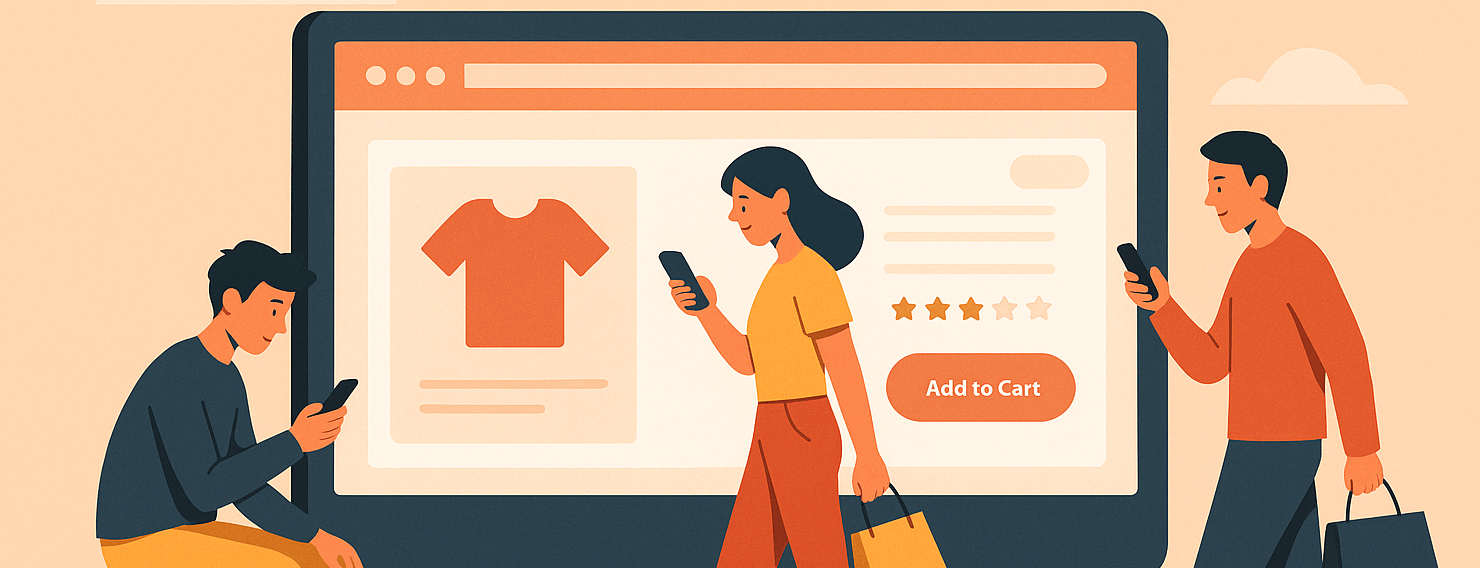Table of Contents
Pull up almost any ecommerce stat today and you’ll see the same headline: over 70% of online shopping traffic now comes from mobile. That’s right, most people are scrolling, browsing, and adding items to their carts straight from their phones.
Yet, when it comes to actually clicking “buy,” the desktop still wins. Conversion rates are consistently higher on laptops and desktops, even though fewer people start there.
That’s the paradox. If nearly every site claims to be “mobile optimized,” why are customers still bailing on their phones? The truth is, optimized doesn’t always mean usable.
And that gap isn’t just a UX quirk, but a revenue leak. Every mobile bounce drives up your CAC/LTV ratio, every abandoned cart drags down AOV, and every clunky interaction shows up later in NPS or CES scores.
So the real question is: why does mobile still fall short, and what separates a site that just fits the screen from one that truly works on it?
Key Takeaways
- Mobile rules traffic, but not loyalty. Phones drive most visits, yet shoppers are happier buying on desktop.
- Shrink-to-fit isn’t enough. Responsive design doesn’t fix clunky menus, checkout pain, or slow load times.
- Friction kills carts. Tiny buttons, endless forms, and laggy pages = abandoned orders.
- Bad UX costs more than sales. It chips away at satisfaction, CES, and NPS, hurting long-term trust.
- Mobile-first wins. One-thumb navigation, one-tap checkout, and smart content hierarchy turn frustration into conversion.
The Illusion of Optimization
Let’s rewind for a second. In the early days of mobile shopping, most sites were just shrink-to-fit versions of their desktop layouts. You’d pinch and zoom your way through tiny product descriptions and microscopic “Add to Cart” buttons. Not exactly smooth.
Then came responsive design, which felt like a huge leap forward. Sites could finally resize themselves to match your screen. No more awkward zooming – what a relief! Later, the conversation shifted to mobile-first design, where sites were actually built with the phone in mind from the start.
Here’s the problem, though: responsive solves appearance, not experience. Just because a page looks neat on a phone doesn’t mean it’s easy or pleasant to shop on.
Take a fashion retailer’s mobile site as an example. The product images look sharp, the text fits the screen, and everything seems polished. But once you start shopping, it’s a different story: clunky navigation, too many checkout fields, and no mobile wallet support. Result? A whopping cart abandonment rate – proof that “looking good” doesn’t always equal “working well.”
At the end of the day, the difference between optimized and usable is simple: one fits, the other actually flows.
Where the Struggles Really Happen (with Data)
So, where exactly do shoppers get stuck on mobile? The short answer: pretty much everywhere. The longer answer breaks down into a few big pain points backed by data:
- Navigation friction: Hidden menus, endless scrolling, and poor categorization are classic culprits. Studies show that confusing navigation leads to higher bounce rates, because if customers can’t find what they want fast, they leave.
- Clumsy interactions: Ever tried tapping a button so small you weren’t sure if you hit “Buy” or “Back”? Usability studies repeatedly show that tiny tap zones and hard-to-read text frustrate users. What feels like a minor design choice can mean the difference between a smooth path and a rage quit.
- Checkout killers: This is where the money is lost. Long forms, no auto-fill, and a lack of mobile wallet support push shoppers away. In fact, the Baymard Institute reports that over 70% of carts are abandoned, with a big chunk due to complicated checkouts. Compare that to Amazon’s famous one-click checkout, which removes friction entirely and you see why it works.
- Performance lag: Here’s the stat that stings: according to Google, a 1-second delay in load time can drop conversions by up to 20% in retail. Heavy images, too many pop-ups, or slow-loading scripts are silent killers. On mobile, where attention spans are razor-thin, speed is survival.
Put it all together, and you see the problem. A site that “looks” mobile-friendly can still drive shoppers away if it’s clunky, confusing, or slow. And while Amazon’s seamless mobile flow proves what’s possible, most retailers are still tripping over the basics.
Beyond Speed: The Psychology of Effort
When we talk about site performance, most people think in terms of actual speed – how many seconds it takes for a page to load. Yet, customers care more about perceived speed than the stopwatch.
Think about it. If you tap a button and nothing happens, even for two seconds, it feels broken. But if the button responds instantly – changes color, shows a spinner, or loads a placeholder image – you know something’s happening, and the wait feels shorter. That’s why smart design tricks like skeleton screens, progress bars, and instant tap feedback matter so much. They don’t just fill time; they ease the frustration of waiting.
Yet effort isn’t only about speed, but also about mental load. The more decisions customers have to make, the more exhausting the experience becomes. Too many options, unclear navigation, or a checkout form with a dozen unnecessary fields all lead to decision fatigue. And once shoppers feel drained, they’re more likely to abandon the process entirely.
Here’s a simple contrast: scrolling Instagram feels effortless; you’re guided by visuals, smooth interactions and instant feedback. Compare that to browsing a clunky mobile website where you’re zooming, scrolling endlessly, and second-guessing every tap. Same phone, same thumb, but one feels natural while the other feels like work.
In other words, a great mobile experience isn’t simply fast, it feels effortless.
Why Desktop Still Feels Safer
Mobile might rule when it comes to browsing, but desktop still dominates when it comes to buying, especially for big-ticket items.
Why? For starters, larger screens make life easier. You can compare products side by side, check reviews without flipping between tabs, and actually see all the little details, like shipping fees or return policies, that are easy to miss on a phone. Bigger screens also make trust cues more visible. Security badges, clear pricing, and product specs all feel more “official” on a laptop than crammed onto a four-inch display.
Data backs this up. Across industries, average order value (AOV) is consistently higher on desktop than on mobile. Shoppers might grab a quick impulse buy on their phone – a pair of earbuds, a snack delivery – but when it comes to a laptop, a sofa, or a $1,000 phone upgrade, they prefer the space and safety of a desktop checkout.
Mobile also comes with built-in disadvantages. You’re juggling distractions – notifications, texts, background apps – and typing out payment details on a tiny keyboard never feels secure. That “less safe” feeling lingers, especially when it comes to entering sensitive information for larger purchases.
So, the pattern is clear: impulse buys thrive on mobile, planned purchases still migrate to desktop. And until brands close that trust and comfort gap, that split isn’t going away anytime soon.
What Defines a Truly Great Mobile Experience
So if “mobile optimized” isn’t enough, what does a great mobile experience actually look like? The best brands nail a few simple, but powerful, principles:
- Keep it simple: On mobile, every extra tap feels like a hurdle. Shorter forms, fewer steps, and clear CTAs make all the difference. If checkout feels like a sprint, people stick with it. If it feels like a marathon, they drop out.
- Design for mobile, not just on it: The best sites mimic the feel of native apps. Think swipe-to-view galleries, sticky “Add to Cart” buttons that follow you down the page, or one-click checkout that feels effortless. These touches feel natural on a phone and keep the flow going.
- Build trust in plain sight: Mobile users shouldn’t have to hunt for reassurance. Upfront shipping info, visible reviews, and recognizable payment icons make people feel safe. Trust cues work like guardrails. They let shoppers move forward without hesitation.
- Personalize without overwhelming: On a small screen, clutter is deadly. The best mobile experiences surface just the right nudges – “Complete the look” or “Customers also bought” – without burying shoppers in pop-ups or irrelevant AI recommendations.
Take ASOS, for example. Their mobile checkout integrates PayPal, Apple Pay, and Google Pay, so you can buy with a tap. Add swipe-friendly galleries and real-time delivery info, and the whole experience feels seamless, like the site was designed for your phone, not just shrunk down to fit it.
In short, a great mobile experience is creating a journey that feels fast, trustworthy, and effortless on the device people actually use the most.
The Ecosystem Layer (Beyond Design)
Even the cleanest, most polished mobile site will fall flat if the ecosystem around it isn’t working together. A great mobile experience involves everything that happens before, during, and after the purchase.
It starts with friction-free payments. Typing out a 16-digit card number on a phone is torture. That’s why mobile wallets like Apple Pay and Google Pay are game-changers, cutting checkout from minutes to seconds with Face ID or a fingerprint. The easier it is to pay, the fewer carts get left behind.
From there, consistency across channels becomes non-negotiable. Shoppers don’t think in terms of “mobile vs. desktop” – they just see your brand. They might spot a product on Instagram, explore it on mobile, then complete the order on desktop or in-store. If those touchpoints don’t line up, trust slips. But when the look, feel, and flow are unified across site, app, and social, the brand feels dependable.
And the journey doesn’t stop at checkout. Post-purchase experiences, from order tracking to delivery updates and support, are part of the mobile story too. Smart brands lean into SMS updates, push notifications, or WhatsApp messages to confirm orders, share delivery timelines, and check in with customers. A simple text that says “Your order is on the way” is a small touch that keeps buyers feeling cared for.
The same ecosystem logic also explains where mobile is headed. The best experiences are already blending into Progressive Web Apps (PWAs), which load instantly, work offline, and send push notifications without requiring an app download. Meanwhile, conversational commerce, through chatbots, live chat, or even voice assistants, turns searching into asking: “Show me black sneakers under $100” is faster than five taps. Add in AI-driven recommendations, like Starbucks suggesting drinks based on the weather and your past orders, and mobile starts to feel predictive rather than repetitive.
To sum up:
- PWAs → best for global/fast-scaling brands.
- Conversational commerce → quick win for fashion/CPG where impulse buys matter.
- AI recs → huge especially for high-SKU catalogs (fashion, electronics) by surfacing the right products at the right time.
The takeaway? Mobile experience isn’t designed in isolation. When payments, channels, post-purchase touchpoints, and emerging technologies all connect, shopping on a phone finally feels as easy and natural as it should.
Actionable Moves for Brands
So what can brands actually do about all this? Here are some clear steps to start closing the gap between “mobile optimized” and a true mobile experience:
- Don’t assume responsive = good. Just because your site resizes on a phone doesn’t mean it’s usable. Grab a real device (or better yet, a few different ones) and walk through the entire journey yourself, from homepage to checkout. You’ll quickly spot friction points that don’t show up in a desktop preview.
- Benchmark your numbers. Dig into your analytics and compare conversion rate, bounce rate, and average order value (AOV) by device. If the desktop is still dramatically ahead, it’s a clear signal that your mobile experience needs work.
- Look for quick wins. Enable mobile wallets like Apple Pay and Google Pay. Move to one-page checkout, if possible. Trim down forms (also by using auto-fill, saved addresses, and email/phone logins) so they can be filled out in seconds. Add perceived speed cues: progress bars, skeleton screens, instant button feedback. Place security badges, reviews, and clear shipping info where shoppers need them most – at checkout. Clean up hidden menus and endless scrolls that drive up bounce. These are small tweaks with outsized impact.
- Think long-term, too. If you’re serious about winning on mobile, start exploring bigger plays: progressive web apps for app-like performance without the download, conversational UX that guides shoppers instead of making them dig, and AI-driven personalization that makes every tap feel intuitive.
At the end of the day, the brands that win on mobile will be the ones that design for ease, trust, and effortlessness, not just for screen fit. Responsive design is the baseline. The real game is making mobile shopping feel so smooth that customers never think twice about finishing the purchase right where they started: on their phones.
Closing Thought
By now it’s clear: “mobile optimized” is the floor, not the ceiling. Resizing a desktop site for a phone screen doesn’t guarantee a smooth, trustworthy, or enjoyable shopping journey.
The brands that win are the ones that go further, cutting friction at checkout, anticipating needs with personalization, and making mobile shopping feel natural instead of forced. In other words, success won’t come from being “responsive,” but from being responsible for the full mobile experience.
Mobile UX leaves plenty of signals if you know where to look:
- Load time: every second of delay costs conversions.
- Cart abandonment rate: especially high on mobile, and almost always tied to friction.
- Scroll depth & tap heatmaps: where shoppers lose interest or rage-tap.
- Post-purchase CES/NPS scores: the direct voice of your customers, telling you how the journey really felt.
Analytics show you what’s happening. Surveys tell you why. Together, they give you the map to improve.
Bottom line? The best mobile stores aren’t flawless; they’re relentless. They measure, learn, and keep refining every scroll, tap, and survey until the journey feels effortless.


































 Christina Sol
Christina Sol 




 Greg Raileanu
Greg Raileanu 